Study of the Behavior of Structural Materials Treated with Bioconsolidant
Abstract
:1. Introduction
2. Bioconsolidation: Microbial Contribution to the Conservation of the Existing Building Heritage
- In an autotrophic way;
- In a heterotrophic way.
- The ammonification of amino acids under anaerobic conditions in the presence of organic matter and calcium;
- The dissimilar reduction in nitrates under anaerobic and microaerophilic conditions in the presence of organic matter, calcium, and nitrate;
- The hydrolysis of urea or uric acid in the presence of urease and in an environment rich in organic substances and calcium.
- Concentration of dissolved inorganic carbon (DIC);
- Calcium ion concentration;
- pH;
- Availability of nucleation sites and/or development of crystals for nucleation.
3. Selection of Stone Materials
3.1. Natural Stone Material: Novelda Stone
3.2. Artificial Stone Material: Lime Mortar
4. Determination of the Mechanical Characteristics of Untreated Specimens
4.1. Preparation of the Specimens
4.2. Types of Tests Performed
4.2.1. Non-Destructive Diagnostic Test: Direct Ultrasonic Test
4.2.2. Static-Type Destructive Mechanical Tests: Flexural Strength Test and Compressive Strength Test
4.3. Experimental Results
4.3.1. Direct Ultrasonic Test
4.3.2. Flexural Strength Test
4.3.3. Compressive Strength Test
5. Experimental Procedure: Determination of the Mechanical Characteristics of the Bioconsolidated Specimens
5.1. Bioconsolidation of the Specimens
Application of the Nutritional Solution
5.2. Types of Tests Performed
5.3. Experimental Results
5.3.1. Direct Ultrasonic Test
5.3.2. Flexural Strength Test
5.3.3. Compressive Strength Test
6. Qualitative Analysis by SEM and Optical Microphotography
6.1. Microscopic Techniques for Microstructural Analysis of Samples Treated with MYXOSTONE M3P
Optical Microscopy
6.2. Experimental Results: Optical Photomicrographs
6.3. Scanning Electron Microscopy
6.4. Experimental Results: SEM Photomicrograph
7. Interpretation of the Results
7.1. Direct Ultrasonic Test: Pulse Propagation Speed
7.2. Flexural Strength
7.3. Compressive Strength
7.4. Microstructural Analysis
8. Conclusions
Author Contributions
Funding
Institutional Review Board Statement
Informed Consent Statement
Data Availability Statement
Conflicts of Interest
References
- Delgado Rodrigues, J.; Ferreira Pinto, A.P. Stone consolidation by biomineralisation. Contribution for a new conceptual and practical approach to consolidate soft decayed limestones. J. Cult. Herit. 2019, 39, 82–92. [Google Scholar] [CrossRef]
- Seifan, M.; Berenjian, A. Microbially induced calcium carbonate precipitation: A widespread phenomenon in the biological world. Appl. Microbiol. Biotechnol. 2019, 103, 4693–4708. [Google Scholar] [CrossRef] [PubMed]
- Ortega-Morales, B.O.; Gaylarde, C.C. Bioconservation of historic stone buildings—An updated review. Appl. Sci. 2021, 11, 5695. [Google Scholar] [CrossRef]
- Joseph, E. Microorganisms in the Deterioration and Preservation of Cultural Heritage; Springer Nature: Berlin/Heidelberg, Germany, 2021; p. 367. [Google Scholar]
- De Muynck, W.; De Belie, N.; Verstraete, W. Microbial carbonate precipitation in construction materials: A review. In Karapanagiotis; Springer International Publishing: Cham, Switzerland, 2018; pp. 185–207. [Google Scholar]
- Sena da Fonseca, B.; Ferreira Pinto, A.P.; Piçarra, S.; Montemor, M.d.F. Alkoxysilane-based sols for consolidation of carbonate stones: Proposal of methodology to support the design and development of new consolidants. J. Cult. Herit. 2020, 37, 63–72. [Google Scholar] [CrossRef]
- Sena da Fonseca, B.; Ferreira, M.J.; Taryba, M.G.; Piçarra, S.; Piçarra, S.; Ferreira Pinto, A.P.; Montemor, M.d.F. Alkoxysilane-based sols for consolidation of carbonate stones: Impact of the carbonate medium in the sol-gel processes. J. Cult. Herit. 2019, 43, 51–63. [Google Scholar] [CrossRef]
- Daskalakis, M.I.; Magoulas, A.; Kotoulas, G.; Katsikis, I.; Bakolas, A.; Karageorgis, A.P.; Mavridou, A.; Doulia, D.; Rigas, F. Pseudomonas, Pantoea and Cupriavidus isolates induce calcium carbonate precipitation for biorestoration of ornamental stone. J. Appl. Microbiol. 2013, 115, 409–423. [Google Scholar] [CrossRef]
- Daskalakis, M.I.; Rigas, F.; Bakolas, A.; Magoulas, A.; Kotoulas, G.; Katsikis, I.; Karageorgis, A.P.; Mavridou, A. Vaterite bio-precipitation induced by Bacillus pumilus isolated from a solutional cave in Paiania, Athens, Greece. Int. Biodeter. Biodegr. 2015, 99, 73–84. [Google Scholar] [CrossRef]
- Mihajlovski, A.; Gabarre, A.; Seyer, D.; Bousta, F.; Di Martino, P. Bacterial diversity on rock surface of the ruined part of a French historic monument: The Chaalis abbey. Int. Biodeter. Biodegr. 2017, 120, 161–169. [Google Scholar] [CrossRef]
- Negi, A.; Sarethy, I.P. Microbial biodeterioration of cultural heritage: Events, colonization, and analyses. Microb. Ecol. 2019, 78, 1014–1029. [Google Scholar] [CrossRef]
- Rodriguez-Navarro, C.; Jroundi, F.; Gonzalez-Muñoz, M.T. Stone consolidation by bacterial carbonatogenesis: Evaluation of in situ applications. Restor. Build. Monum. 2015, 21, 9–20. [Google Scholar] [CrossRef]
- Coelho, C.; Mesquita, N.; Costa, I.; Soares, F.; Trovão, J.; Freitas, H.; Portugal, A.; Tiago, I. Bacterial and archaeal structural diversity in several biodeterioration patterns on the limestone walls of the old cathedral of Coimbra. Microorganisms 2021, 9, 709. [Google Scholar] [CrossRef]
- Jroundi, F.; Elert, K.; Ruiz-Agudo, E.; Gonzalez-Muñoz, M.T.; Rodriguez-Navarro, C. Bacterial Diversity Evolution in Maya Plaster and Stone Following a Bio-Conservation Treatment. Front. Microbiol. 2020, 11, 599144. [Google Scholar] [CrossRef] [PubMed]
- De Muynck, W.; Verbeken, K.; De Belie, N.; Verstraete, W. Influence of temperature on the effectiveness of a biogenic carbonate surface treatment for limestone conservation. Appl. Microbiol. Biotechnol. 2013, 97, 1335–1347. [Google Scholar] [CrossRef] [PubMed]
- Jroundi, F.; Schiro, M.; Ruiz-Agudo, E.; Elert, K.; Martín-Sánchez, I.; González-Muñoz, M.T.; Rodriguez-Navarro, C. Protection and consolidation of stone heritage by self-inoculation with indigenous carbonatogenic bacterial communities. Nat. Commun. 2017, 8, 279. [Google Scholar] [CrossRef] [PubMed] [Green Version]
- Li, Q.; Zhang, B.; Yang, X.; Ge, Q. Deterioration-associated microbiome of stone monuments: Structure, variation, and assembly. Appl. Environ. Microbiol. 2018, 84, e02680-17. [Google Scholar] [CrossRef] [Green Version]
- Marvasi, M.; Cavalieri, D.; Mastromei, G.; Casaccia, A.; Perito, B. Omics technologies for an in-depth investigation of biodeterioration of cultural heritage. Int. Biodeter. Biodegr. 2019, 144, 104736. [Google Scholar] [CrossRef]
- Montaño-Salazar, S.M.; Lizarazo-Marriaga, J.; Brandão, P.F.B. Isolation and Potential Biocementation of Calcite Precipitation Inducing Bacteria from Colombian Buildings. Curr. Microbiol. 2018, 75, 256–265. [Google Scholar]
- Park, S.-J.; Park, Y.-M.; Chun, W.-Y.; Kim, W.-J.; Ghim, S.-Y. Calcite-forming bacteria for compressive strength improvement in mortar. J. Microbiol. Biotechnol. 2010, 20, 782–788. [Google Scholar]
- Sterflinger, K.; Little, B.; Pinar, G.; Pinzari, F.; de los Rios, A.; Gu, J.-D. Future directions and challenges in biodeterioration research on historic materials and cultural properties. Int. Biodeter. Biodegr. 2018, 129, 10–12. [Google Scholar] [CrossRef]
- Dhami, N.K.; Alsubhi, W.R.; Watkin, E.; Mukherjee, A. Bacterial community dynamics and biocement formation during stimulation and augmentation: Implications for soil consolidation. Front. Microbiol. 2017, 8, 1267. [Google Scholar] [CrossRef] [Green Version]
- Cameotra, S.S.; Dakal, T.C. Carbonatogenesis: Microbial contribution to the conservation of monuments and stone artwork. Conser. Sci. Cult. Herit. 2012, 12, 79–108. [Google Scholar]
- Castanier, S.; Le Métayer-Levrel, G.; Perthuisot, J.P. Ca-carbonates precipitation and limestone genesis-the microbiogeologist point of view. Sediment. Geol. 1999 126, 9–23. [CrossRef]
- Hammes, F.; Verstraete, W. Key roles of pH and calcium metabolism in microbial carbonate precipitation. Environ. Sci. Biotechnol. 2002, 1, 3–7. [Google Scholar] [CrossRef]
- Ramachandran, S.K.; Ramakrishnan, V.; Bang, S.S. Remediation of concrete using microorganisms. ACI Mater. J. 2001, 98, 3–9. [Google Scholar]
- Sarda, D.; Choonia, H.S.; Sarode, D.D.; Lele, S.S. Biocalcification by Bacillus pasteurii urease: A novel application. J. Ind. Microbiol. Biotechnol. 2009, 36, 1111–1115. [Google Scholar] [CrossRef] [PubMed]
- Kaur Dhami, N.; Reddy, S.M.; Mukherjee, A. Biofilm and Microbial Applications in Biomineralized Concrete, Advanced Topics in Biomineralization; Seto, J., Ed.; IntechOpen: London, UK, 17 February 2012. [Google Scholar] [CrossRef] [Green Version]
- Fort, R.; Bernabéu, A.; García del Cura, M.A.; López de Azcona, M.; Ordóñez, S.; Mingarro, F. Novelda stone: Widely used within the spanish architectural heritage. Mater. Constr. 2002, 52, 19–32. [Google Scholar] [CrossRef]
- García del Cura, M.A.; Rodríguez, M.A.; Cañaveras, J.C.; Bernabéu, A.; Ordóñez, S. La riqueza geológica de piedra natural en la provincia de Alicante. RocMaquina 2005, 96, 66–72. [Google Scholar]
- Ordóñez, S.; Louis, M.; García del Cura, M.A.; Fort, R.; López de Azcona, M.; Mingarro, F. Physical properties and petrographic characteristics of some Bateig stone varieties. In Proceedings of the Seventh International Congress/ International Association of Engineering Geology, Lisboa, Portugal, 5–9 September 1994; Volume 5, pp. 3595–3603. [Google Scholar]
- Zhang, Z.X. Rock Fracture and Blasting: Theory and Applications; Butterworth-Heinemann: Oxford, UK, 2016. [Google Scholar]
- Bernabéu, A.; Ordóñez, S.; García del Cura, M.A. Origen de eflorescencias de yeso en rocas ornamentales porosas. Inf. Tecnol. 2000, 11, 119–124. [Google Scholar]
- Benavente, D.; García del Cura, M.A.; Fort, R.; Ordóñez, S. Durability estimation of porous building stones from pore stucture and strength. Eng. Geol. 2004, 74, 113–127. [Google Scholar] [CrossRef]
- Di Mundo, R.; Labianca, C.; Carbone, G.; Notarnicola, M. Recent advances in hydrophobic and icephobic surface treatments of concrete. Coatings 2020, 10, 449. [Google Scholar] [CrossRef]
- Anovitz, L.M.; Cole, D.R. Characterization and analysis of porosity and pore structures. Rev. Mineral. Geochem. 2015, 80, 61–164. [Google Scholar] [CrossRef] [Green Version]
- Uhlrich, C.; Gwyn, D. Stone quarrying landscapes as world heritage sites. Int. Commit. Conserv. Ind. Herit. 2015, 2015, 1–18. [Google Scholar]
- IGME. Mármoles de España; Instituto Tecnológico GeoMinero de España: Madrid, Spain, 1991. [Google Scholar]
- Claisse, P.A. Civil Engineering Materials; Butterworth-Heinemann: Oxford, UK, 2016. [Google Scholar]
- Menéndez, B. Non-Destructive Techniques Applied to Monumental Stone Conservation; IntechOpen: London, UK, 2016; Volume 8, pp. 173–213. [Google Scholar]
- González-Muñoz, M.T. Bacterial biomineralization applied to the protection-consolidation of ornamental stone: Current development and perspectives. Coalition 2008, 15, 12–18. [Google Scholar]
- Jroundi, F.; Bedmar, E.J.; Rodriguez-Navarro, C.; Gonzalez-Muñoz, M.T. Consolidation of ornamental stone by microbial carbonatogenesis. Glob. Stone Congr. 2010, 2010, 1–5. [Google Scholar]
- Rodriguez-Navarro, C.; Jroundi, F.; Schiro, M.; Ruiz-Agudo, E.; González-Muñoz, M.T. Influence of substrate mineralogy on bacterial mineralization of calcium carbonate: Implications for stone conservation. Appl. Environ. Microbiol. 2012, 78, 4017–4029. [Google Scholar] [CrossRef] [Green Version]
- Suryanarayana, C. Microstructure: An introduction. In Aerospace Materials and Material Technologies; Springer: Berlin, Germany, 2017; Volume 6, pp. 105–123. [Google Scholar]


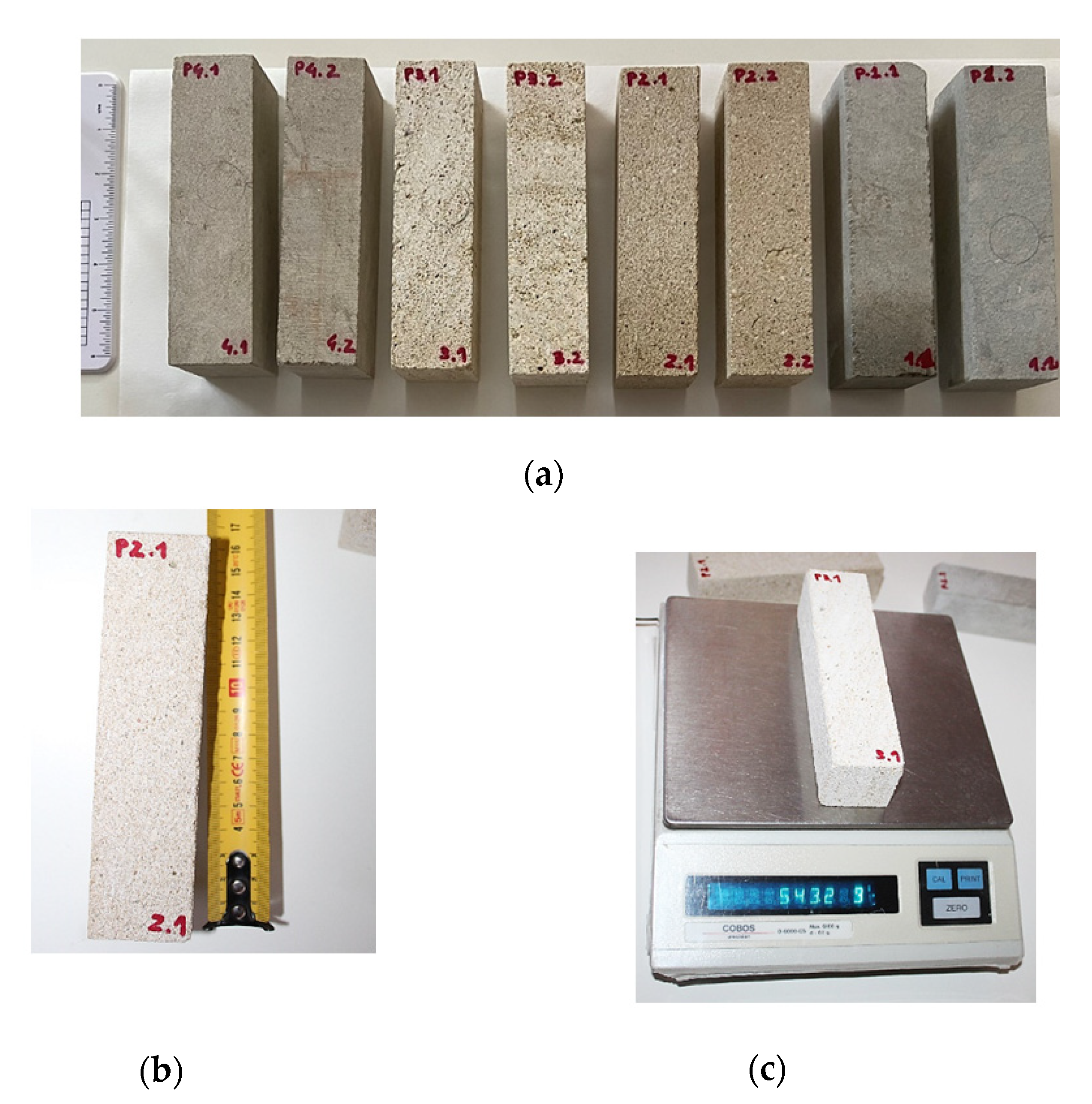


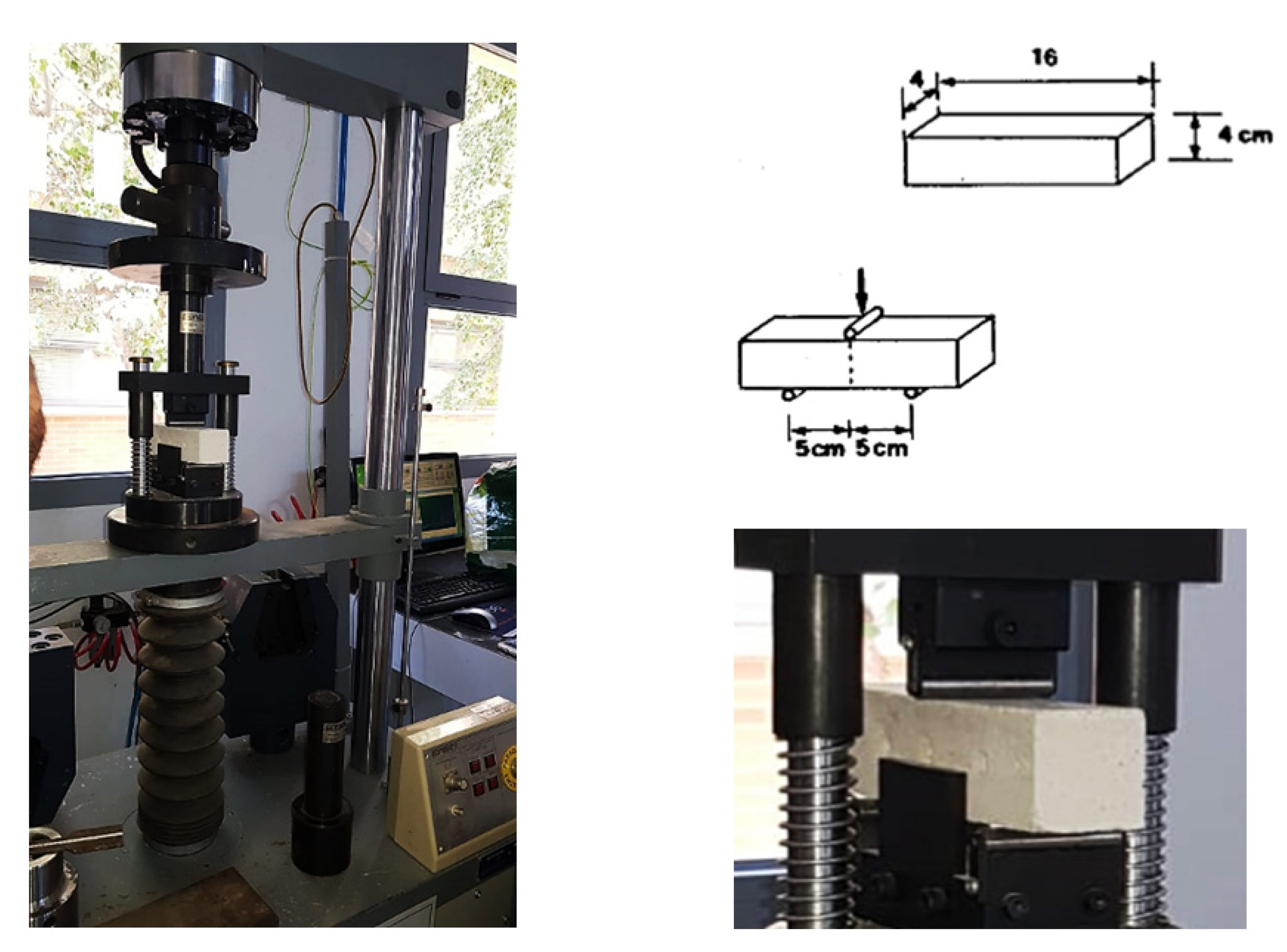
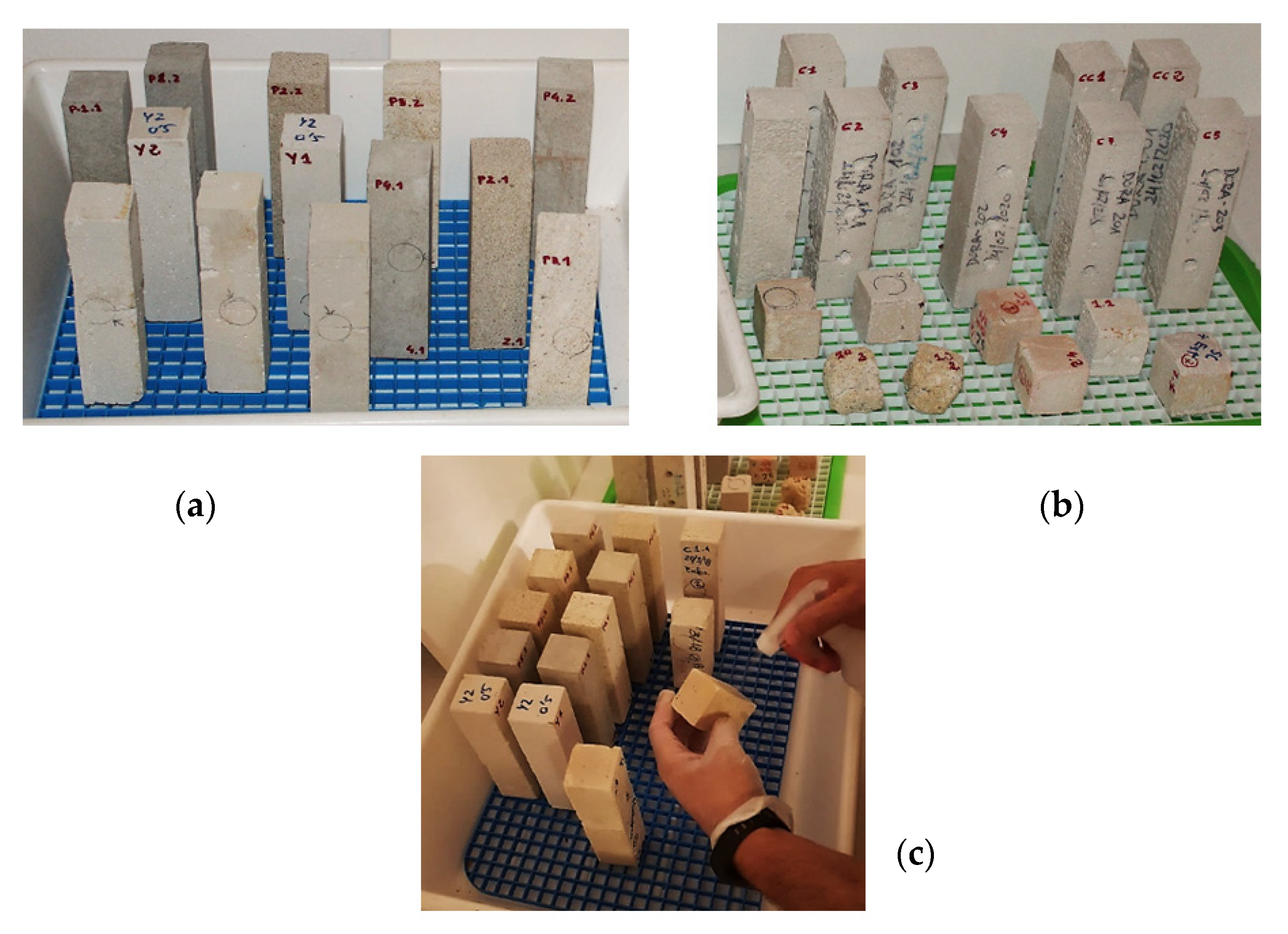
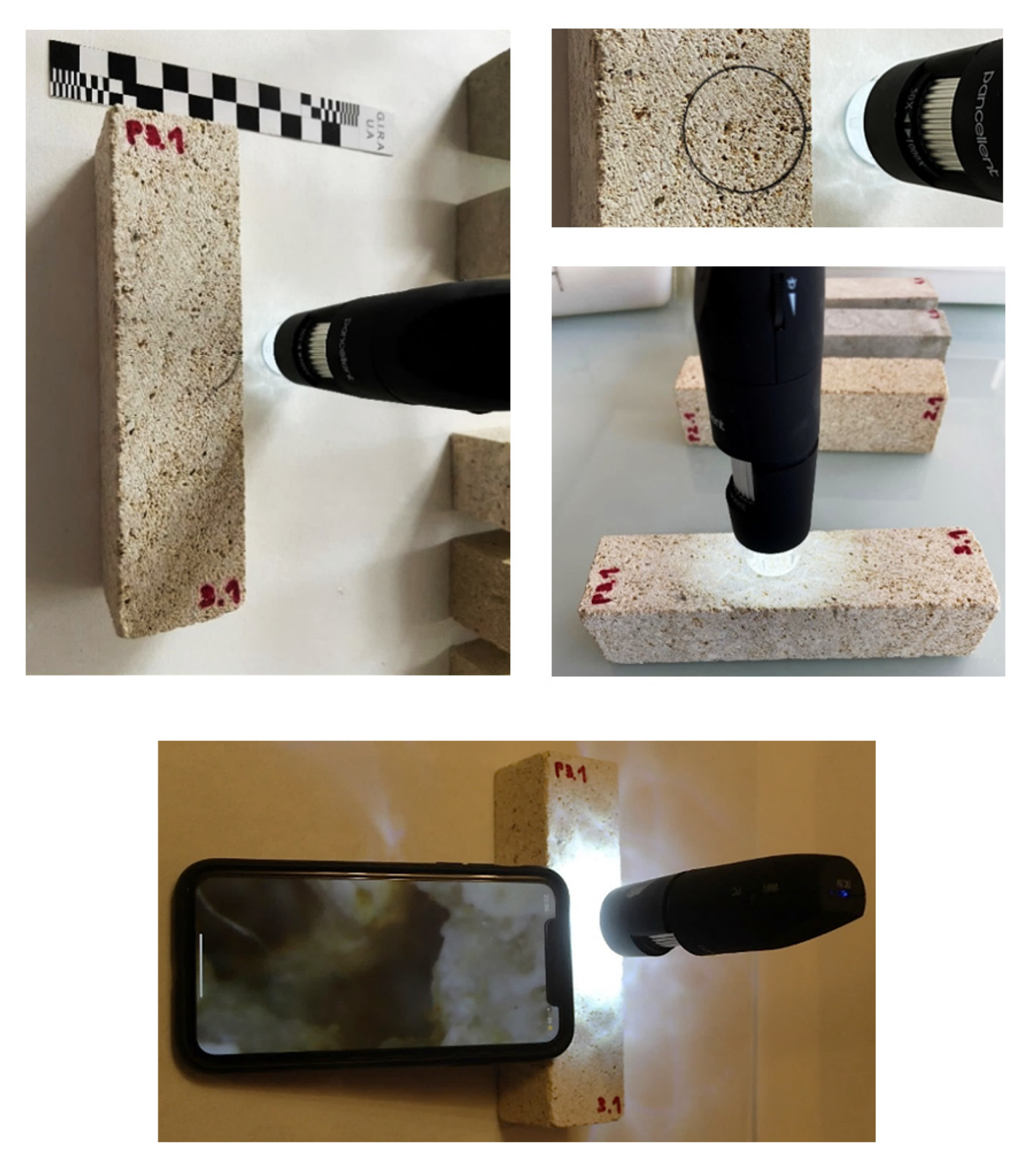
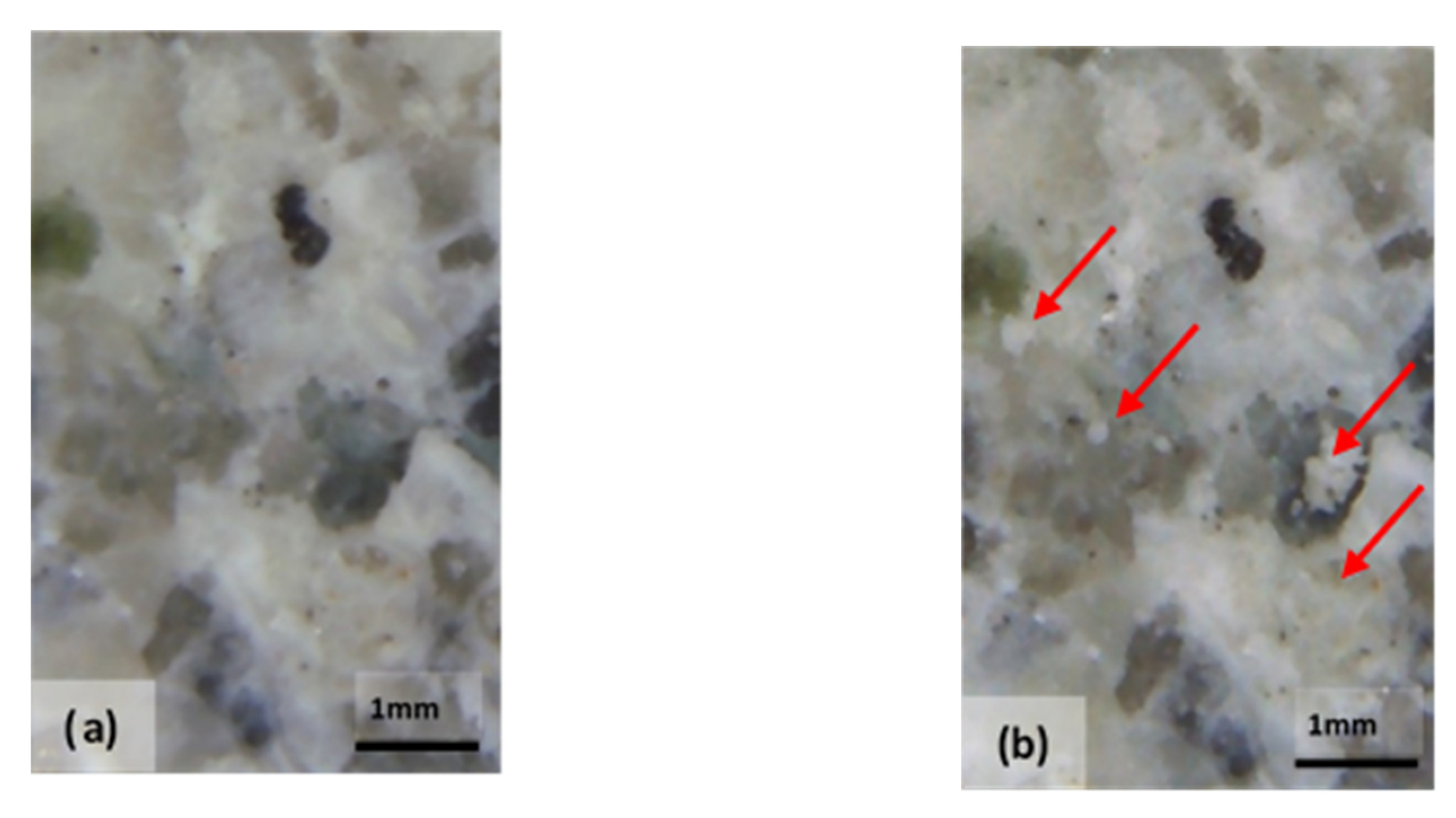
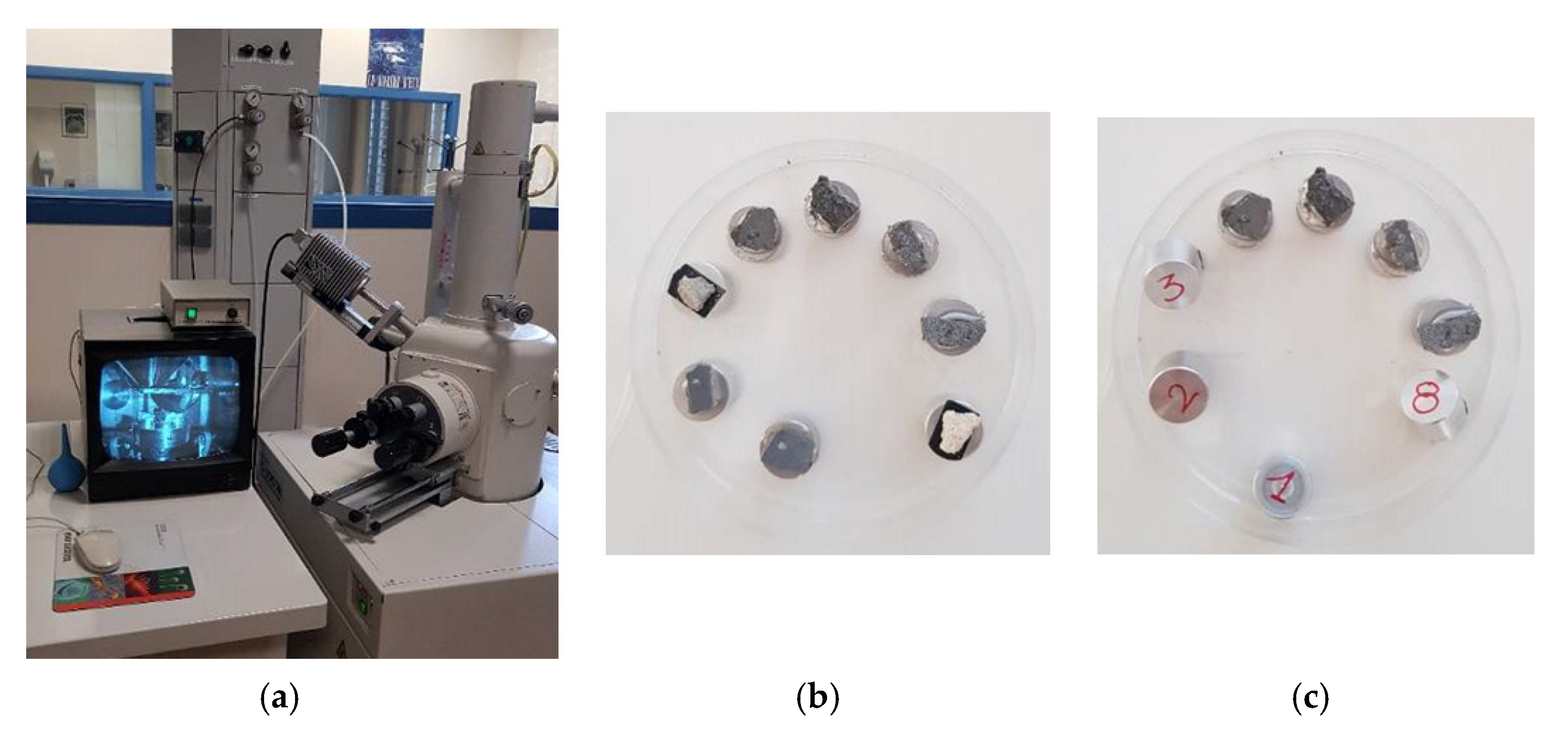

| Material | Code | Untreated Specimen | Code Designation ** | Treated Specimens | Code Designation ** |
|---|---|---|---|---|---|
| Diamante Stone | P4 | 2 | P4.X.UT | 2 | P4.X.T |
| Crema Maroc Stone | P3 | 2 | P3.X.UT | 2 | P3.X.T |
| Beige Hydra Stone | P2 | 2 | P2.X.UT | 2 | P2.X.T |
| Blue Stone | P1 | 2 | P1.X.UT | 2 | P1.X.T |
| Lime Mortar | C | 3 | C.X.UT | 3 | C.X.T |
| Lime Mortar Control *** | CC | 2 | C.X.UT | - | - |
| Bateig Stone (40 × 40 × 160 mm) | L (mm) | T (ms) | T (s) | V (km/s) |
|---|---|---|---|---|
| P4-Diamante | 160 | 53.1 | 0.0531 | 3.013 × 10−3 |
| P3-Crema Maroc | 160 | 49.8 | 0.0498 | 3.213 × 10−3 |
| P2-Beige Hydra | 160 | 51.4 | 0.0514 | 3.113 × 10−3 |
| P1-Blue | 160 | 47.4 | 0.0474 | 3.376 × 10−3 |
| Lime Mortar (40 × 40 × 160 mm) | L (mm) | T (ms) | T (s) | V (mm/s) | V (km/s) |
|---|---|---|---|---|---|
| C | 160 | 75 | 0.075 | 2134 | 2.134 × 10−3 |
| CC *** | 160 | 72.15 | 0.0725 | 2171.5 | 2.172 10−3 |
| Bateig Stone (40 × 40 × 160 mm) | Ff (N) | Rf (N/mm2) |
|---|---|---|
| P4-Diamante | 3130 | 7.34 |
| P3-Crema Maroc | 3380 | 7.92 |
| P2-Beige Hydra | 4850 | 11.37 |
| P1-Blue | 4880 | 11.44 |
| Bateig Stone | Fc (N) | Rc (N/mm2) |
|---|---|---|
| P4-Diamante | 52,100 | 32.57 |
| P3-Crema Maroc | 46,750 | 29.22 |
| P2-Beige Hydra | 87,250 | 54.54 |
| P1-Blue | 62,033.33 | 38.77 |
| Bateig Stone (40 × 40 × 160 mm) | L (mm) | T (ms) | T (s) | V (km/s) |
|---|---|---|---|---|
| P4-Diamante | 160 | 52.9 | 0.0529 | 3.025 × 10−3 |
| P3-Crema Maroc | 160 | 49.7 | 0.0497 | 3.219 × 10−3 |
| P2-Beige Hydra | 160 | 48.9 | 0.0489 | 3.272 × 10−3 |
| P1-Blue | 160 | 46.6 | 0.0466 | 3.433 × 10−3 |
| Lime Mortar (40 × 40 × 160 mm) | L (mm) | T (ms) | T (s) | V (mm/s) | V (km/s) |
|---|---|---|---|---|---|
| C | 160 | 71.4 | 0.0714 | 2244.6 | 2.244 × 10−3 |
| CC *** | 160 | 71 | 0.07125 | 2213.5 | 2.213 × 10−3 |
| Bateig Stone (40 × 40 × 160 mm) | Ff (N) | Rf (N/mm2) |
|---|---|---|
| P4-Diamante | 6040 | 14.16 |
| P3-Crema Maroc | 3120 | 7.31 |
| P2-Beige Hydra | 3060 | 7.17 |
| P1-Blue | 5620 | 13.17 |
| Lime Mortar (40 × 40 × 160 mm) | Ff (N) | Rf (N/mm2) |
|---|---|---|
| C1 | 1066.67 | 2.5 |
| CC ** | 1205 | 2.81 |
| Bateig Stone | Fc (N) | Rc (N/mm2) |
|---|---|---|
| P4-Diamante | 88,215 | 55.14 |
| P3-Crema Maroc | 42,515 | 26.57 |
| P2-Beige Hydra | 45,000 | 28.125 |
| P1-Blue | 82,240 | 51.4 |
| Lime Mortar | Fc (N) | Rc (N/mm2) |
|---|---|---|
| C1 | 9938.33 | 6.21 |
| CC ** | 11,095 | 6.94 |
| Sample | 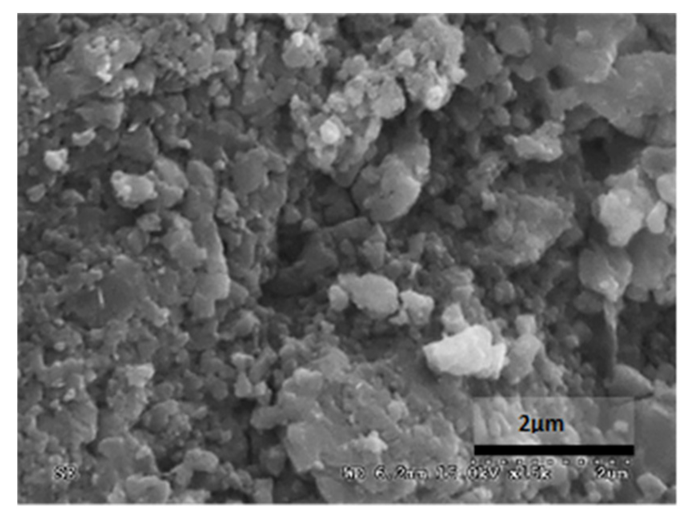 |
| Blue Bateig Stone not bioconsolidated | |
| Conductive coating | |
| Iridium (Ir) | |
| SEM microphotography in secondary electrons | |
| Enlargement: X 15k = 15,000 X Depth of field: 2 μm | |
| Sample | 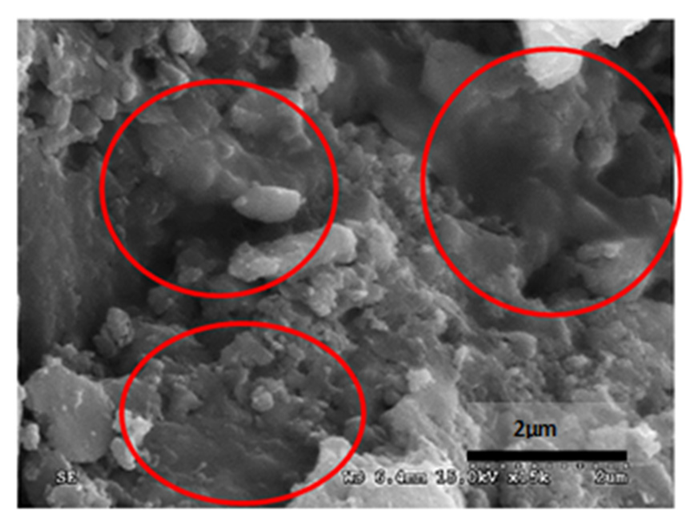 |
| Bioconsolidated Blue Bateig Stone | |
| Conductive coating | |
| Iridium (Ir) | |
| Microfotografia SEM in secondary electrons | |
| Enlargement: X 15k = 15,000 X Depth of field: 2μm | |
| Sample | 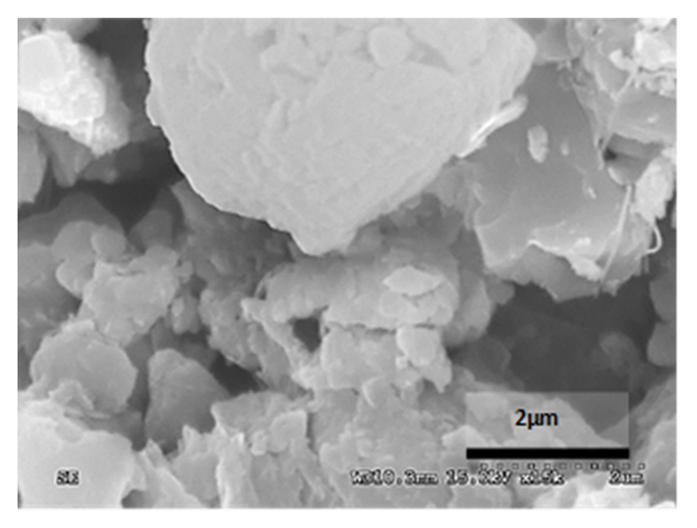 |
| Maroc Cream Bateig Stone not bioconsolidated | |
| Conductive coating | |
| Iridium (Ir) | |
| SEM microphotography in secondary electrons | |
| Enlargement: X 15k = 15,000 X Depth of field: 2 μm | |
| Sample |  |
| Bioconsolidated Bateig Stone Maroc Cream | |
| Conductive coating | |
| Iridium (Ir) | |
| SEM microphotography in secondary electrons | |
| Enlargement: X 15k = 15,000 X Depth of field: 2 μm | |
| Sample | 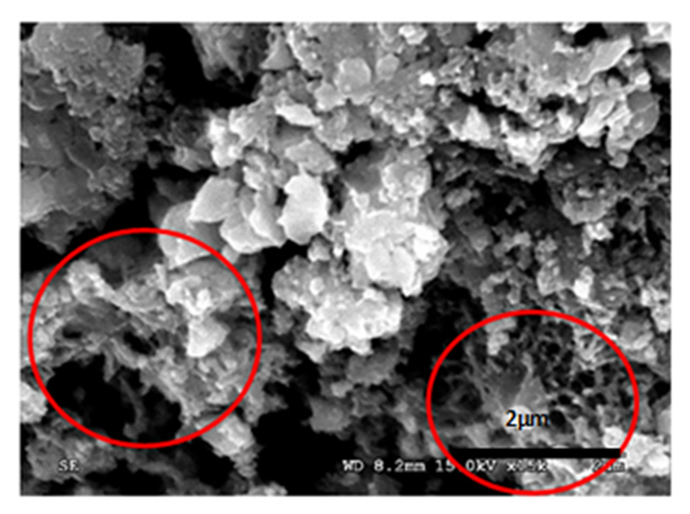 |
| Lime mortar not bioconsolidated | |
| Conductive coating | |
| Iridium (Ir) | |
| SEM microphotography in secondary electrons | |
| Enlargement: X 15k = 15,000 X Depth of field: 2 μm | |
| Sample |  |
| Bioconsolidated lime mortar | |
| Conductive coating | |
| Iridium (Ir) | |
| SEM microphotography in secondary electrons | |
| Enlargement: X 15k = 15,000 X Depth of field: 2 μm With 50× enlargement and a depth of field of 1 mm, the formation of calcium carbonate crystals can be observed. | |
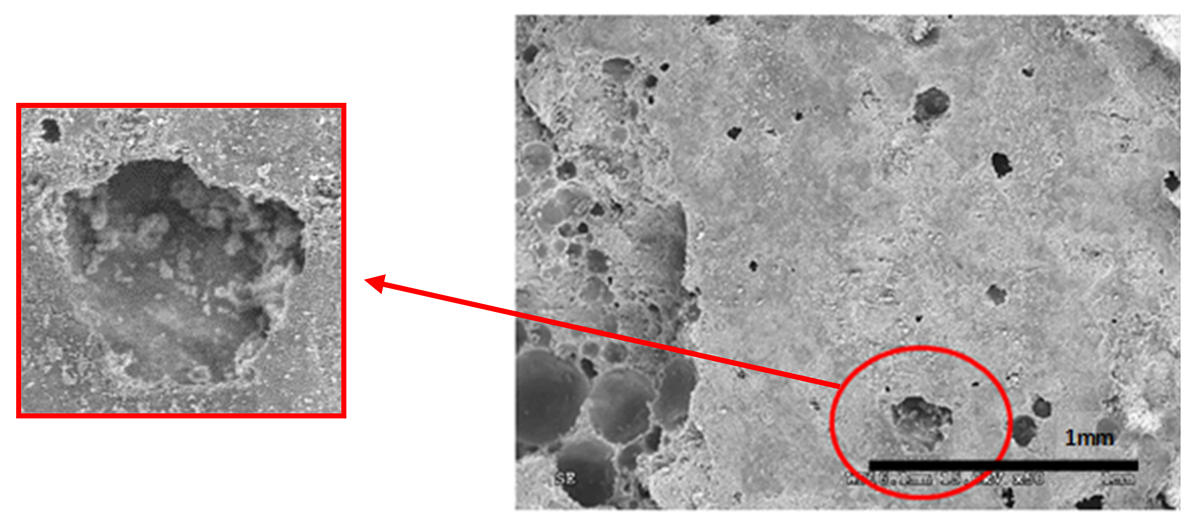 | |
| Bateig Stone | L (mm) | Before Treatment | After Treatment |
|---|---|---|---|
| V (m/s) | V (km/s) | ||
| P4-Diamante | 160 | 3.013 × 10−3 | 3.025 × 10−3 |
| P3-Crema Maroc | 160 | 3.213 × 10−3 | 3.219 × 10−3 |
| P2-Beige Hydra | 160 | 3.113 × 10−3 | 3.272 × 10−3 |
| P1-Blue | 160 | 3.376 × 10−3 | 3.433 × 10−3 |
| Lime Mortar | L (mm) | Before Treatment | After Treatment |
|---|---|---|---|
| V (km/s) | V (km/s) | ||
| C | 160 | 2.134 × 10−3 | 2.244 × 10−3 |
| CC ** | 160 | 2.222 × 10−3 | 2.302 × 10−3 ** |
| Bateig Stone | Before Treatment | After Treatment |
|---|---|---|
| Rf (MPa) | Rf (MPa) | |
| Diamante | 7.34 | 14.16 |
| Crema Maroc | 7.92 | 7.31 |
| Beige Hydra | 11.37 | 7.17 |
| Blue | 11.44 | 13.17 |
| Bateig Stone | Before Treatment | After Treatment |
|---|---|---|
| Rc (MPa) | Rc (MPa) | |
| P4-Diamante | 32.57 | 55.14 |
| P3-Crema Maroc | 29.22 | 26.57 |
| P2-Beige Hydra | 54.54 | 28.125 |
| P1-Blue | 38.77 | 51.4 |
Publisher’s Note: MDPI stays neutral with regard to jurisdictional claims in published maps and institutional affiliations. |
© 2021 by the authors. Licensee MDPI, Basel, Switzerland. This article is an open access article distributed under the terms and conditions of the Creative Commons Attribution (CC BY) license (https://creativecommons.org/licenses/by/4.0/).
Share and Cite
Spairani, Y.; Cisternino, A.; Foti, D.; Lerna, M.; Ivorra, S. Study of the Behavior of Structural Materials Treated with Bioconsolidant. Materials 2021, 14, 5369. https://doi.org/10.3390/ma14185369
Spairani Y, Cisternino A, Foti D, Lerna M, Ivorra S. Study of the Behavior of Structural Materials Treated with Bioconsolidant. Materials. 2021; 14(18):5369. https://doi.org/10.3390/ma14185369
Chicago/Turabian StyleSpairani, Yolanda, Arianna Cisternino, Dora Foti, Michela Lerna, and Salvador Ivorra. 2021. "Study of the Behavior of Structural Materials Treated with Bioconsolidant" Materials 14, no. 18: 5369. https://doi.org/10.3390/ma14185369








